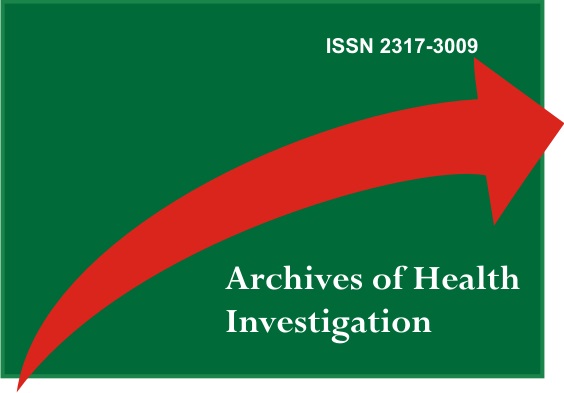Root caries among homeless people: prevalence and associated factors
DOI:
https://doi.org/10.21270/archi.v10i9.5221Keywords:
Root Caries, Homeless Persons, Adults, Elderly patient. Chlorhexidine. Pneumonia., Oral Health, Health VulnerabilityAbstract
Introduction: Root caries has been investigated in the general population, but the evidence in homeless people is limited. Objective: To investigate the prevalence of root caries and its association with sociodemographic factors, drug use and oral health in homeless persons. Material and Method: Cross-sectional study with 116 individuals aged 18 to 68 years from Goiânia, Goiás. Data were collected through interviews and clinical examination, based on the criteria of the World Health Organization. The outcome was the prevalence of root caries. The covariables were sociodemographic characteristics, use of licit and illicit drugs, number of remaining teeth, DMFT index and use of removable partial denture. In the statistical analysis, bivariate comparisons and Poisson regression with robust variance were used. Results: The prevalence of root caries was 26.4% (95% CI = 19.0-35.5), with an average of 0.76 roots per individual. All affected roots were decayed and untreated and the most affected teeth were the posterior ones. A higher prevalence was found in individuals with higher age, number of remaining teeth and DMFT index. After adjustment, only age remained associated with the outcome (PR = 1.03; 95% CI = 1.00-1.06). Conclusion: More than ¼ of the homeless individuals surveyed had root caries and the prevalence was associated with increasing age. The lack of restored roots suggests the need to promote the access of this population group to health services.
Downloads
References
Brasil. Decreto Presidencial no 7.053, de 23 de dezembro de 2009. Institui a Política Nacional para a População em Situação de Rua e seu comitê intersetorial de acompanhamento e monitoramento. Diário Oficial da União 2009; 24 dez.
Brasil. Meta Instituto de Pesquisa de Opinião/Ministério do Desenvolvimento Social e de Combate à Fome. Secretaria de Avaliação e Gestão da Informação. Pesquisa Nacional sobre a População em Situação de Rua. Sumário executivo. Brasília: Ministério do Desenvolvimento Social e de Combate à Fome; 2008.
Natalino MAC. Estimativa da população em situação de rua no Brasil. Instituto de Pesquisa Econômica Aplicada. Brasília, DF: Rio de Janeiro: Ipea, 2016.
Brasil. Ministério da Saúde. Secretaria de Atenção à Saúde. Departamento de Atenção Básica. Manual sobre o cuidado à saúde junto a população em situação de rua. Brasília: Ministério da Saúde; 2012.
Brasil. Ministério da Saúde. Secretaria de Gestão Estratégica e Participativa. Departamento de Apoio à Gestão Participativa. Saúde da população em situação de rua: um direito humano. Brasília: Ministério da Saúde; 2014.
Ritter AV, Shugars DA, Bader JD. Root caries risk indicators: a systematic review of risk models. Community Dent Oral Epidemiol. 2010;38:383-97.
Zhang J, Leung KCM, Sardana D, Wong MCM, Lo ECM. Risk predictors of dental root caries: A systematic review. J Dent. 2019;89:103166.
Pentapati KC, Siddiq H, Yeturu SK. Global and regional estimates of the prevalence of root caries – Systematic review and meta-analysis. Saudi Dent J. 2019;31:3-15.
Marques RAA, Antunes JLF, Sousa MLR, Peres MA, Frazão P. Prevalência e extensão da cárie dentária radicular em adultos e idosos brasileiros. Rev Saúde Pública. 2013;47(Supl 3):59-68.
Waplington J, Morris J, Bradnock G. The dental needs, demands and attitudes of a group of homeless people with mental health problems. Community Dent Health. 2000;17:134-7.
Daly B, Newton JT, Batchelor P. Patterns of dental service use among homeless people using a targeted service. J Public Health Dent. 2010;70:45–51.
Brasil. Ministério da Saúde. Secretaria de Atenção à Saúde. Departamento de Atenção Básica. Projeto SB Brasil 2010: Pesquisa Nacional de Saúde Bucal. Resultados principais. Brasília: Ministério da Saúde; 2011.
World Health Organization. Oral health surveys: basic methods. 4. ed. Geneva; 1997.
Instituto Brasileiro de Geografia e Estatística (IBGE). Censo Brasileiro 2010. Rio de Janeiro: IBGE; 2010.
Victora CG, Huttly SR, Fuchs SC, Olinto MTA. The role of conceptual frameworks in epidemiological analysis: a hierarchical approach. Int J Epidemiol. 1997;26:224-7.
Rihs LB, Sousa MLR, Wada RS. Prevalência de cárie radicular em adultos e idosos na região sudeste do Estado de São Paulo, Brasil. Cad Saúde Pública. 2005;21:311-6.
Splieth Ch, Schwahn Ch, Bernhardt O, John U. Prevalence and distribution of root caries in Pomerania, North-East Germany. Caries Res. 2004;38:333-40.
Kularatne S, Ekanayake L. Root surface caries in older individuals from Sri Lanka. Caries Res. 2007;41:252-6.
Du MQ, Jiang H, Tai BJ, Zhou Y, Wu B, Bian Z. Root caries patterns and risk factors of middle-aged and elderly people in China. Community Dent Oral Epidemiol. 2009;37:260-6.
Bidinotto AB, Martins AB, Dos Santos CM, Hugo FN, Hilgert JB, Celeste RK, Padilha DM, De Marchi RJ. Four-year incidence rate and predictors of root caries among community-dwelling south Brazilian older adults. Community Dent Oral Epidemiol. 2018;46:125-31.
Nicolau B, Srisilapan P, Marcenes W. Number of teeth and risk of root caries. Gerodontology. 2000;17:91-6.
Hecht SS, Friedman J. High incidence of cervical dental caries among drug addicts. Oral Surg. 1949;2:1428-42.
Fazel S, Khosla V, Doll H, Geddes J. The prevalence of mental disorders among the homeless in western countries: systematic review and meta-regression analysis. PLoS Med. 2008;5:e225.
Katz RV. Assessing root caries in populations: the evolution of the root caries index. J Public Health Dent. 1980;40:7-16.


